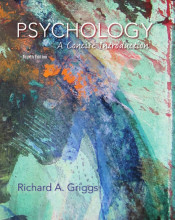Disorders of childhood
20 important questions on Disorders of childhood
Which two types of childhood disorders are distinguished?
- externalizing disorders; are characterised by more outward-directed behaviours, such as aggressiveness, noncompliance, overactivity, and impulsiveness (ADHD, conduct disorder, oppositional defiant disorder)
- internalizing disorders; are characterised by more inward-focused experiences and behaviours, such as depression, social withdrawal, and anxiety (childhood anxiety and mood disorders)
Which three subtypes of ADHD does the dsm 5 distinguish, and how are these characterized?
- Predominantly inattentive: kids whose problems are primarily of poor attention
- Predominantly hyperactive: children whose difficulties result primarily from hyperactive/impulsive behaviour
- Combined: children who have both sets of problems (most common)
Describe the genetic factors in ADHD.
- heritability estimates as high as 70 to 80%
- 3 dopamine genes have been implicated in ADHD:
- DRD4 (dopamine receptor gene)
- DRD5 (dopamine receptor gene)
- DAT1 (dopamine transporter gene)
- SNAP-25 that codes for a protein that promotes plasticity (adaptability) of neuron synapses also been associated with ADHD
- Higher grades + faster learning
- Never study anything twice
- 100% sure, 100% understanding
What are the neurobiological factors that could weight in on ADHD?
- Brain structure, function, and connectivity differ in children with and without ADHD, particularly in areas linked to dopamine
- Dopaminergic areas of brain like caudate nucleus, globus pallidus, and frontal lobes smaller in children with ADHD
- Exhibit less activation in frontal areas of brain
- Perform poorly on neuropsychological tests that rely on frontal lobes (like inhibiting behavioural responses) basic deficit in frontal lobes may lead to ADHD
What are the family factors that could contribute to ADHD?
- Parent-child relationship interacts with neurobiological factors in a complex way to contribute to ADHD symptom expression
- As children take medication, parents’ commands, negative behaviour, and ineffective parenting decrease, suggesting child’s behaviour has at least some negative effects on parents’ behaviour
- Many parents have ADHD themselves (genetic component)
- Fathers with ADHD were less effective parents
- Family characteristics thus may well contribute to maintaining or exacerbating symptoms and consequences of ADHD, but little evidence to suggest families actually cause ADHD
Which treatments for ADHD are there?
- Stimulant medications; Methylphenidate (Ritalin), Adderall, Concerta, Strattera
- Multimodal Treatment of Children with ADHD (MTA) compared standard community-based care with medication alone, medication plus intensive behavioural treatment with parents and teachers, and intensive behavioural treatment alone
- Psychological treatment
- Parent training and changes in classroom management have shown a least short-term success in improving both social and academic behaviour
What are is the prevalence of conduct disorder?
Describe dodge's cognitive theory of aggression in conduct disorder?
- ambiguous action interpreted as hostile
- aggression toward others
- retaliation from others
- further angry aggression toward others
What are the prevalences for depression in children?
2-3% of school-age children under 13
Adolescence rates of depression range from 6-16% for girls and 4-7% for boys and gender difference doesn’t occur before age 12
What treatments for depression are there?
- Treatment for Adolescents with Depression Study (TADS) indicated that combined treatment of Prozac and CBT was most effective through 12 weeks and Prozac had modest advantages compared to CBT, even after 36 weeks
Medication kids at risk for suicide ideation (side effects of meds)
CBT is school settings effective and associated with more rapid reduction of symptoms than family or supportive therapy
63% show improvement but may not last long
Describe the dsm 5 criteria for separation anxiety
- Excessive anxiety that is not developmentally appropriate about being away from people to whom one is attached, with at least 3 symptoms that last for at least 4 weeks (6 months for adults)
- Repeated and excessive distress when separated
- Excessive worry that something bad will happen to an attachment figure
- Refusal or reluctance to go to school, work, or elsewhere
- Refusal or reluctance to sleep away from home
- Nightmares about separation from attachment figure
- Repeated and excessive distress when separated
What is the prevalence of separation anxiety?
What treatments for anxiety disorder are there?
Major focus on exposure, including more modeling and reinforcement than adult treatments
CBT can be helpful (family better than individual when both parents have anxiety disorder)
Behaviour therapy and group cognitive therapy effective for social anxiety disorder
Less data about CBT for OCD
Bibliotherapy: parents given written materials and are therapist with children
Computer-assisted therapy
CBT for PTSD
What are the dsm 5 criteria for specific learning disorder
- Difficulties in learning basic academic skills (reading, mathematics, or writing) inconsistent with person’s age, schooling, and intelligence persisting for at least 6 months
- Significant interference with academic achievement or activities of daily living
Describe the etiology of dyscalcula.
- The type of math disability that involves poor semantic memory is most likely to be heritable.
- Any genes associated with dyscalculia are also associated with mathematics ability.
- People with dyscalculia have less active parietal lobe during math tasks. → specifically intraparietal sulcus.
- Dyslexia and dyscalculia are independent, phonological awareness deficits only in dyslexia and manipulation of numbers are troubled in dyscalculia.
Which treatments for specific learning disorder are there?
- Traditional linguistic approach focus on instruction in listening, speaking reading and writing skills in a logical manner such as reading out loud under close supervision.
- In young children readiness skills may need to be taught before.
- Phonic instruction is beneficial.
Describe the dsm 5 criteria for intellectual and developmental disabilities?
- Deficits in intellectual functioning
- Deficits in adaptive functioning: communication, social participation, work school (at least 1)
- An onset during development
- The severity of intellectual disability is assessed in 3 domains: social, conceptual, practical.
What is the prevalence of ASD?
Affects 1 out of 68.
4 times more boys than girls.
Diagnosis are remarkably stable
Describe the genetic factors in ASD.
- Heritability of 0.80.
- Shared environmental factors accounted for over a half of the risk for developed autism.
- ASD is linked genetically to a broader spectrum of deficits in communication and social interaction. In families where more than one child has ASD or language delay, unaffected siblings also exhibited deficits in social communication.
- Deletion on chromosome 16 was associated with ASD in three different samples. → a genetic flaw.
Which treatments for ASD are there?
Usually aimed at reducing their unusual behavior and improving their communication and social skills. Earlier intervention is better.
- Behavioral treatment
- medication
The question on the page originate from the summary of the following study material:
- A unique study and practice tool
- Never study anything twice again
- Get the grades you hope for
- 100% sure, 100% understanding
































